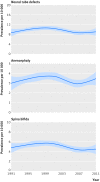Long term trends in prevalence of neural tube defects in Europe: population based study
- PMID: 26601850
- PMCID: PMC4658393
- DOI: 10.1136/bmj.h5949
Long term trends in prevalence of neural tube defects in Europe: population based study
Abstract
Study question: What are the long term trends in the total (live births, fetal deaths, and terminations of pregnancy for fetal anomaly) and live birth prevalence of neural tube defects (NTD) in Europe, where many countries have issued recommendations for folic acid supplementation but a policy for mandatory folic acid fortification of food does not exist?
Methods: This was a population based, observational study using data on 11,353 cases of NTD not associated with chromosomal anomalies, including 4162 cases of anencephaly and 5776 cases of spina bifida from 28 EUROCAT (European Surveillance of Congenital Anomalies) registries covering approximately 12.5 million births in 19 countries between 1991 and 2011. The main outcome measures were total and live birth prevalence of NTD, as well as anencephaly and spina bifida, with time trends analysed using random effects Poisson regression models to account for heterogeneities across registries and splines to model non-linear time trends.
Summary answer and limitations: Overall, the pooled total prevalence of NTD during the study period was 9.1 per 10,000 births. Prevalence of NTD fluctuated slightly but without an obvious downward trend, with the final estimate of the pooled total prevalence of NTD in 2011 similar to that in 1991. Estimates from Poisson models that took registry heterogeneities into account showed an annual increase of 4% (prevalence ratio 1.04, 95% confidence interval 1.01 to 1.07) in 1995-99 and a decrease of 3% per year in 1999-2003 (0.97, 0.95 to 0.99), with stable rates thereafter. The trend patterns for anencephaly and spina bifida were similar, but neither anomaly decreased substantially over time. The live birth prevalence of NTD generally decreased, especially for anencephaly. Registration problems or other data artefacts cannot be excluded as a partial explanation of the observed trends (or lack thereof) in the prevalence of NTD.
What this study adds: In the absence of mandatory fortification, the prevalence of NTD has not decreased in Europe despite longstanding recommendations aimed at promoting peri-conceptional folic acid supplementation and existence of voluntary folic acid fortification.
Funding, competing interests, data sharing: The study was funded by the European Public Health Commission, EUROCAT Joint Action 2011-2013. HD and ML received support from the European Commission DG Sanco during the conduct of this study. No additional data available.
© Khoshnood et al 2015.
Conflict of interest statement
Competing interests: All authors have completed the ICMJE uniform disclosure form at
Figures


Comment in
-
Folic acid fortification for Europe?BMJ. 2015 Nov 24;351:h6198. doi: 10.1136/bmj.h6198. BMJ. 2015. PMID: 26602789 No abstract available.
-
Folic acid to prevent neural tube defects: another solution.BMJ. 2016 Feb 16;352:i763. doi: 10.1136/bmj.i763. BMJ. 2016. PMID: 26883078 No abstract available.
-
Authors' reply to Amitai and Koren.BMJ. 2016 Feb 16;352:i769. doi: 10.1136/bmj.i769. BMJ. 2016. PMID: 26884423 No abstract available.
References
Publication types
MeSH terms
Substances
LinkOut - more resources
Full Text Sources
Other Literature Sources
Medical
